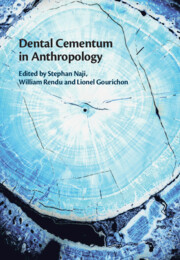Book contents
- Dental Cementum in Anthropology
- Dental Cementum in Anthropology
- Copyright page
- Dedication
- Contents
- Contributors
- Foreword
- Introduction: Cementochronology in Chronobiology
- Part I The Biology of Cementum
- 1 A Brief History of Cemental Annuli Research, with Emphasis upon Anthropological Applications
- 2 Development and Structure of Cementum
- 3 Insights into Cementogenesis from Human Disease and Genetically Engineered Mouse Models
- 4 A Comparative Genetic Analysis of Acellular Cementum
- 5 Pattern of Human Cementum Deposition with a Special Emphasis on Hypercementosis
- 6 Recent Advances on Acellular Cementum Increments Composition Using Synchrotron X-Radiation
- 7 Incremental Elemental Distribution in Chimpanzee Cellular Cementum: Insights from Synchrotron X-Ray Fluorescence and Implications for Life-History Inferences
- 8 Identifying Life-History Events in Dental Cementum: A Literature Review
- Part II Protocols
- Part III Applications
- Index
- Plate Section (PDF Only)
- References
8 - Identifying Life-History Events in Dental Cementum: A Literature Review
from Part I - The Biology of Cementum
Published online by Cambridge University Press: 20 January 2022
- Dental Cementum in Anthropology
- Dental Cementum in Anthropology
- Copyright page
- Dedication
- Contents
- Contributors
- Foreword
- Introduction: Cementochronology in Chronobiology
- Part I The Biology of Cementum
- 1 A Brief History of Cemental Annuli Research, with Emphasis upon Anthropological Applications
- 2 Development and Structure of Cementum
- 3 Insights into Cementogenesis from Human Disease and Genetically Engineered Mouse Models
- 4 A Comparative Genetic Analysis of Acellular Cementum
- 5 Pattern of Human Cementum Deposition with a Special Emphasis on Hypercementosis
- 6 Recent Advances on Acellular Cementum Increments Composition Using Synchrotron X-Radiation
- 7 Incremental Elemental Distribution in Chimpanzee Cellular Cementum: Insights from Synchrotron X-Ray Fluorescence and Implications for Life-History Inferences
- 8 Identifying Life-History Events in Dental Cementum: A Literature Review
- Part II Protocols
- Part III Applications
- Index
- Plate Section (PDF Only)
- References
Summary
The circannual rhythm and continuous growth of cementum throughout life have been seen by many researchers as offering an exciting window of potential information of life history recorded in the shape, texture, and chemistry of its increments. A host of studies have thus been presented studying the relationship between these factors and various life history events affecting mammal physiology, most notably pregnancy and parturition. This chapter reviews the literature that has tested this assumption directly, in animals and in humans. Also, we offer theoretical and methodological insights into future advances in cementochronology specifically for identifying and recording these life-history events.
- Type
- Chapter
- Information
- Dental Cementum in Anthropology , pp. 155 - 170Publisher: Cambridge University PressPrint publication year: 2022
References
- 1
- Cited by

